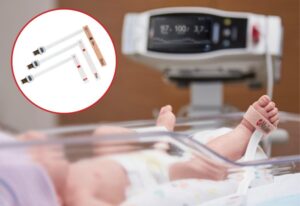
Brynne Sullivan, MD
A team of neonatal researchers at UVA Children’s, Washington University in St. Louis, and the University of Alabama at Birmingham, co-led by Brynne Sullivan, MD, in the Department of Pediatrics, received $3.1 million from the National Institutes of Health to study cardiorespiratory signatures of neonatal opioid withdrawal syndrome (NOWS), a rising health concern affecting newborn infants exposed to opioids in utero with lifelong consequences.
NOWS has seen a troubling surge in recent years, with its upward trajectory accelerated by the global pandemic. The proposed research underscores the pressing need to better understand its pathophysiology and optimize the treatment of affected infants. The research team aims to develop a Pulse Oximetry Withdrawal Score (POWS), a novel technology for objective symptom assessment to guide treatment and hospital length of stay. As the opioid epidemic continues to evolve, targeted research like this becomes imperative in our collective endeavor to mitigate its impact on health systems and families.
What is NOWS?
NOWS is a complex disorder with variable presentation and severity. Symptoms include extreme irritability, difficulty feeding, respiratory problems, and seizures. The current gold standard for NOWS evaluation and treatment uses subjective evaluation and symptom monitoring to guide the provision of non-pharmacologic and pharmacologic treatments. Inter-observer assessment variability and overlap with normal neonatal behavior lead to substantial ambiguity and variation in care. These challenges contribute to delays in treatment, hospital discharge, and care inequities.
Vital Sign Analytics
The autonomic nervous system controls vital functions of physiology, including heart rate and breathing. Heart rate variability (HRV; the variance in time between successive heartbeats) and respiratory stability are established physiologic biomarkers of autonomic function. NOWS manifests predominantly as symptoms of autonomic hyperexcitability, which can be detected using quantitative analysis of non-invasive heart rate (HR) and oxygenation (SpO2) data. Pulse oximeters measure HR and SpO2 non-invasively and have sensors fully developed and used ubiquitously for neonates.
POWS for NOWS
 The research team consists of experts in vital sign analytics to detect abnormal patterns caused by neonatal sepsis. They recognized similar patterns due to autonomic dysfunction in infants with NOWS and conducted preliminary studies with promising results. The awarded grant will apply methods extensively developed for sepsis detection to this new disease focus, NOWS, with the goal of developing technology ready for clinical testing. The proposed technology, POWS for NOWS, will be a novel tool for objective symptom assessment that could fundamentally alter management by standardizing care and shortening hospital stays.
The research team consists of experts in vital sign analytics to detect abnormal patterns caused by neonatal sepsis. They recognized similar patterns due to autonomic dysfunction in infants with NOWS and conducted preliminary studies with promising results. The awarded grant will apply methods extensively developed for sepsis detection to this new disease focus, NOWS, with the goal of developing technology ready for clinical testing. The proposed technology, POWS for NOWS, will be a novel tool for objective symptom assessment that could fundamentally alter management by standardizing care and shortening hospital stays.
The Research Team
Co-Primary investigators leading the team are Brynne Sullivan, MD, MSc of UVA Children’s, and Zachary Vesoulis, MD, MSc at Washington University at St. Louis. Drs. Sullivan and Vesoulis are established early-career investigators, both completing successful NIH K23 awards.
Collaborators at the University of Alabama at Birmingham include neonatologists and investigators, Namasivayam Ambalavanan, MD, and Colm Travers, MD. Sherry Kausch, PhD, MSN, MSDS, is a graduate of the UVA Schools of Nursing and Data Science and will be a key UVA team member leading the data analytics for this project. Towards developing technology ready for rigorous clinical testing and widespread use, the team includes a local medical device company, Medical Predictive Science Corporation (MPSC, Charlottesville, VA) led by William King, CEO. To inform product design and engineering, the team plans to compile input from key stakeholders, including parents, providers, and regulatory bodies with the goal of developing prototype devices during the grant award period.
Overarching Goal
The project aims to develop a non-invasive, single-sensor device using routine pulse oximetry data as an objective tool to optimize care for the NOWS infant across hospital settings. A successful device will guide diagnosis and augment care toward improved outcomes and optimized length of stay.
